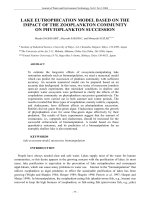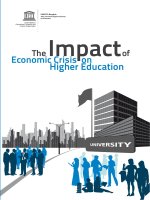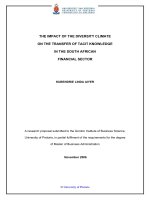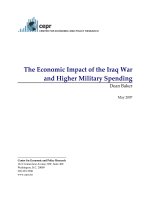Impact of the economic crisis on higher education in east Asia: contry experiences pdf
Bạn đang xem bản rút gọn của tài liệu. Xem và tải ngay bản đầy đủ của tài liệu tại đây (705.01 KB, 219 trang )
Published in the series:
Policy Forum - No. 12
Impact of the economic crisis on
higher education in East Asia :
Country experiences
N. V. Varghese
A paper copy of this publication may be obtained on request from:
To consult the full catalogue of IIEP Publications and documents on our
Web site:
/>Co-operation Agencycation of thi
Published by:
International Institute for Educational Planning/UNESCO
7 - 9 rue Eugène-Delacroix, 75116 Paris
ISBN: 92-803-1213-8
© UNESCO 2001
International Institute for Educational Planning
International Institute for Educational Planning />International Institute for Educational Planning />Forum on Education No. 12
Impact of the economic crisis
on higher education in East Asia:
Country experiences
Selected papers from the Policy Forum
organized jointly with RIHED, Bangkok
and Ministry of Education, Malaysia
Selangor, 29-31 January 2001
Edited by N. V. Varghese
International Institute for Educational Planning
International Institute for Educational Planning />The views and opinions expressed in this booklet are those of the
authors and do not necessarily represent the views of UNESCO, the
IIEP or UNICEF. The designations employed and the presentation of
material throughout this review do not imply the expression of any
opinion whatsoever on the part of UNESCO, the IIEP or UNICEF
concerning the legal status of any country, territory, city or area or
its authorities, or concerning its frontiers or boundaries.
The publication costs have been covered through a grant-in-aid
offered by UNESCO and by voluntary contributions made by several
Member States of UNESCO, the list of which will be found at the end
of the volume.
Published by: International Institute for Educational Planning
7-9 rue Eugène-Delacroix, 75116 Paris
e-mail:
IIEP website: />Cover design: Pierre Finot
Typesetting: Linéale Production
This volume has been printed in IIEP’s printshop
ISBN 92-803-1213-8
© UNESCO 2001
International Institute for Educational Planning />5
CONTENTS
Pages
Preface 7
Abbreviations 11
Introduction 15
I. Impact of the economic crisis on higher education
in East Asia: an overview, N.V. Varghese 23
1. Growth and prosperity in East Asia 23
2. The crisis and its magnitude 26
3. Impact of the crisis on higher education 30
4. Macro-level responses 43
5. Some useful lessons 52
II. Impact of the economic crisis on higher education
in Indonesia, Agung Purwadi 61
1. Introduction 61
2. The nature of the crisis 62
3. Impact of the crisis on higher education 65
4. An assessment of the crisis and its impact on education 75
III. Impact of the economic crisis on higher education
in Korea, Hyunsook Yu 81
1. Introduction 81
2. Beginning of the crisis 84
3. Public policy response to overcome the crisis 88
4. Impact of the crisis on higher education 89
5. Reform policy measures for overcoming the crisis 94
6. An assessment of the crisis and its impact on education 99
IV. Impact of the economic crisis on higher education
in Malaysia, Arif Hassan 103
1. Introduction 103
2. Development and changes in the Malaysian economy 104
3. The nature of the financial crisis of 1997-1998 109
4. Education expansion in Malaysia 111
5. The impact of the economic crisis on higher education 166
6. Emerging issues and concerns 120
International Institute for Educational Planning />Impact of the economic crisis on higher education in East Asia
Country experiences
6
V. Impact of the economic crisis on higher education:
the case of Universiti Utara, Malaysia, Dato Dr Mohd.
Saileh bin 127
1. Introduction 127
2. Higher education system in Malaysia 127
3. Effect of the financial crisis on higher education 129
4. Effect of the crisis in the Universiti Utara Malaysia (UUM) 130
5. Institutional response 139
Conclusion 144
VI. A note on the economic crisis and higher education
in the Philippines, Mona Dumlao-Valisno 147
1. Introduction 147
2. Economic crisis in the Philippines 149
3. Higher education in the Philippines: a prey to the
economic crisis 151
4. Higher education: in the aftermath 152
Conclusion 155
VII. Impact of the economic crisis on higher education
in Singapore, Govindar Shantakumar and Pundarik
Mukhopadhaya 15 7
1. Introduction 157
2. The nature of the crisis 158
3. Higher education in Singapore 160
4. Impact of the crisis on higher education 162
5. Institutional response to the crisis 172
6. An assessment of the crisis and its impact on higher
education 178
Conclusion 181
VIII.Impact of the economic crisis on higher education
in Thailand, N.V. Varghese 187
1. Introduction 187
2. Education and economic growth 188
3. The economic crisis in Thailand 191
4. Impact of the crisis on education: macro level 193
5. Responses at the institutional level 199
6. Concluding observations 202
Appendices 207
International Institute for Educational Planning />7
PREFACE
Growth with equity was the hallmark of the East Asian model of
development. Benefits of growth in national income were more
equally shared in this region than anywhere else worldwide, and high-
performing economies experienced increased production, expansion
of employment opportunities and enhanced household income.
Consequently, the number of people below the poverty line declined
drastically in all of these countries.
Education played an important role in promoting growth and
improving equity in the distribution of wealth. Manufacturing-based
and export-led growth strategy of these economies thrived with an
abundant supply of skilled manpower. In fact, economies in this region
became internationally competitive due to the educated labour force.
Since education paid rich dividends, both public authorities and
households were willing to invest in education. The willingness of
the households to educate their children, accompanied by the
commitment of the state both in terms of policy measures and in terms
of funding, led to a faster progress of education than that experienced
in other parts of the world.
Both universal adult literacy and primary enrolment have already
been achieved by these countries, some of them being at par with
developed countries in terms of enrolment at secondary and tertiary
levels of education. Recent studies have indicated that a major share
of improved growth could be attributed to universalization of
education within these societies. While the possibility of expansion
in enrolment was exhausted at the primary level due to the decline
in childbirth, expansion at secondary and tertiary levels continued.
In fact the fastest growth rate in education was experienced at the
higher education level in the 1990s.
International Institute for Educational Planning />Impact of the economic crisis on higher education in East Asia
Country experiences
8
In short, its near and distant neighbours envied the performance
of East Asian economies. This model became very popular, not only
due to sustained high growth rates, but also due to the absence of
any shocks and crises, which economies of the developed world
occasionally face. However, the 1997 crisis shattered the image of the
crisis-free growth model of East Asia. The crisis, which started as one
of currency in Thailand in July 1997, soon spread in the region as an
economic crisis and it continued for some time after that.
Studies on economic crisis and education are not rare in general
and particularly within the Institute. One of the most celebrated
contributions to this theme was made in the late 1960s through the
Institute’s publication World Economic Crisis and Education. In the
1980s the Institute published other studies on the same theme. All
focused on the failure of the public sector to avoid economic and
educational crises. However, this is not the case in East Asia. The East
Asian economic crisis is neither the product of the profligacy of the
public sector nor inefficiency in its operation. It is the product of
over-investment by over-ambitious private sectors.
How does a crisis in East Asian countries affect their commitment
to education? This was the crucial question that was addressed by
the IIEP study. Since the countries in this region have already achieved
universal primary education and generalized secondary education,
the IIEP study focused more on what happens to higher education in
East Asia during periods of crisis. The East Asian crisis resulted in a
loss of jobs and a decline in household income. The most severely
affected groups, however, are middle-income groups who are
traditional clientele for higher education. The expectation was that
a decline in enrolment may be due to reduced paying capacity of
households to support education, even when their commitment to
children and their education continues to be unquestionable. The
International Institute for Educational Planning />9
Preface
surprising finding of the study was that this expectation was belied
and enrolments did increase in many countries, for various reasons.
How did public policies and the public sector respond to the crisis?
What are its short-term and long-term effects? How may we improve
in the future the way in which we face a crisis situation of this variety?
The IIEP carried out case studies in five of the eight high-performing
economies of Asia in order to answer some of these questions.
We appreciate the efforts made by our colleague, Mr N.V. Varghese,
who directed the regional research, to organize a Policy Forum with
a view to sharing the findings with researchers and policy-makers of
the region. The Policy Forum was organized jointly with SEAMEO
RIHED, Bangkok, and the Department of Higher Education, Ministry
of Education, Malaysia. We are grateful to all those who contributed
towards the success of the forum and to the spreading of its message
to policy-makers both in that region and abroad.
Gudmund Hernes
Director, IIEP
July, 2001
International Institute for Educational Planning />International Institute for Educational Planning />11
LIST OF ABBREVIATIONS
ADB Asian Development Bank
AGR Average Growth Rate
ASEAN Association of South-East Nations
BK Brain Korean
BOT Build-Operate-Transfer
CHED Commission on Higher Education
cif cost including freight
CPF Contributory Provident Fund
CPI Consumer Price Index
COE Centres of Excellence
COD Centres of Development
EDB Economic Development Board
FDI Foreign Direct Investment
fob freight on board
GDP Gross Domestic Product
GECD Gombak Educational and Cultural Development
GER Gross Expenditure for Research
GLCs Government-linked Companies
GNI Gross National Income
GNP Gross National Product
HEI Higher Education Institution
HPAEs High Performing Asian Economies
HPEAEs High Performing East Asian Economies
IIU International Islamic University
IIUM International Islamic University Malaysia
ILO International Labour Office
IMF International Monetary Fund
IND Indonesia
IT Industrial Training
ITE Institute of Technical Education
ITM Institute Technology Mara
KDI Korean Development Institute
KLSE Kuala Lumpur Stock Exchange
International Institute for Educational Planning />Impact of the economic crisis on higher education in East Asia
Country experiences
12
KLSECI Kuala Lumpur Stock Exchange Composite Index
LAN National Accreditation Board
LF Labour Force
MNC Multinational Corporation
MOE KEDI Ministry of Education - Korean Educational Development
Institute
MOEF Ministry of Education
MSC Multimedia Super-Corridor
NDP National Development Policy
NEAC National Economic Action Council
NEP National Education Policy
NERP National Economic Recovery Plan
NGOs Non-Governmental Organizations
NHEF National Higher Education Fund
NIE National Institute of Education
NTU Nanyang Technological University
NUS National University of Singapore
NWC National Wages Council
O&M Other and Miscellaneous
OECD Organisation for Economic Co-operation and Development
OPP Outline Perspective Plan
PESS Philippine Education Sector Study
PG Postgraduate
PG (Cr) Postgraduate (Coursework)
PO GNP No word
PRC Professional Regulation Commission
R&D Research and Development
RM Ringgit (Malaysia)
Rp. Rupiah
SEAMEO Southeast Asian Ministers of Education Organization
SIM Singapore Institute of Management
SMU Singapore Management University
SSN Social Safety Net
SSN PCMT Social Safety Nets: Progress and Future Action Plans
STS Secondary Technical Schools
STHRF Scientific and Technical Human Resource Fund
SVS Secondary Vocational Schools
International Institute for Educational Planning />List of abbreviations
13
TEP Technical Educational Product
TESDA Technical Education and Skills Development Authority
TFP Total Factor Productivity
TNB Tenaga Nasional Berhad
TMB Telkom Malaysi Berhad
UNDP United Nations Development Programme
UG Undergraduate
UNICEF United Nations Children’s Fund
UNITAR (first virtual university of Malaysia)
International Institute for Educational Planning />International Institute for Educational Planning />15
INTRODUCTION
by N.V. Varghese
*
The context
East Asian countries have experienced high growth rates in recent
decades. These high rates were accompanied by reduction of poverty
levels and improvement in equity in the distribution of income. More
importantly, unlike economies of the developed world, these
economies were relatively free from outside shocks and economic
crisis. The growth in the region was led by the export of
manufacturing goods mainly to Japan, the USA and Europe.
Certain features of the East Asian development model are worth
noting. Firstly, the rapid growth of the economy was accompanied
by high employment elasticity of output growth. This led to a fast
expansion of formal-sector employment and increased household
incomes. Second, government expenditure, as a share of GDP, was
low and hence the state could play only a limited role in the
redistribution of income. Poverty reduction and improved income
equality attained in these countries were more the result of an overall
improvement of household incomes, rather than any direct state
intervention. Third, the income elasticity of demand for education
was positive and this was reflected especially in the increasing
demand for post-compulsory levels of education. In other words,
these economies, during this period of growth, were characterized
by expansion in formal-sector employment, improved household
incomes and increased demand for post-compulsory levels of
education.
* Staff member, IIEP.
International Institute for Educational Planning />Impact of the economic crisis on higher education in East Asia
Country experiences
16
The role of the state was more in terms of regulating economic
activities to facilitate a smooth operation of the market than in terms
of financing development activities. Consequently the state was not
a dominant partner in total expenditure of the economy. In fact, the
government expenditure accounted for only around 20 per cent of
the GDP, a share that is lower than the corresponding one in many
industrialized countries. It needs to be noted that even when the
public expenditure ratio was low, these economies maintained a high
social allocation ratio. Nearly 20 per cent of the government
expenditure was allocated to social sectors.
The low public expenditure ratio was not sufficient to develop a
widespread public-funded social security system. The growth-
promoting private sectors considered it neither their responsibility
nor a priority area for investment. Unfortunately, the industrialization
process in these countries had already destroyed the family network
and other social security systems usually found in traditional societies.
In other words, most of the economies had moved out of the
traditional institutions of social security but had not replaced them
with a public social security system commonly found in industrialized
countries.
The IIEP regional project
The recent economic crisis led to an increase in unemployment,
and a sharp decline in household incomes. Some recent surveys
indicate that the impact of the crisis was felt more among those who
were employed in formal sectors of the economy than among those
employe d in urban informal sectors or the traditional rural
agricultural sector. For example, by May 1998, unemployment had
doubled, reaching a staggering figure of 1.5 million in Korea – 6 to
12 million Indonesians lost their jobs in 1998. Similar trends can be
observed in other countries such as Thailand, Malaysia and, to a limited
International Institute for Educational Planning />Introduction
17
extent, Singapore. In the absence of a well-developed social security
system, for the reasons mentioned above, the unemployed became
very vulnerable to the crisis. Given the reduced role of the state, it
could not provide any sustained social safety net for the newly
unemployed. There were instances where the poor were forced to
sell assets for their survival and those better off were squeezing their
expenditure on education.
Economic crisis in the past in many countries has, in general, led
to a reduced share of public expenditure and allocations to social
sectors. Public expenditure as a share of GDP and social expenditure
as a share of public expenditure declined in many developing
countries during periods of economic crisis. This pattern stems
essentially from the policy measures taken in the belief that
inefficiency and non-performance of the public sector lay at the root
of the crisis. The recent economic crisis in East Asia is markedly
different from previous ones, since it is not the public sector that is
at the root of the problem. It is the unrestricted flow of private capital
to the region and its withdrawal that created and accentuated the
crisis.
The impact of the crisis seems to be more at post-compulsory levels
of education. It is the middle-income group that provides the
traditional clientele for higher education and it is the most adversely
affected group as a result of the decline in formal-sector employment
during the crisis period.
The impact of the crisis on higher education will depend on
household response to the demand for education, public policy
response to maintain priority to education and to provide increased
funding support to the sector. In general, a decline in household
incomes is associated with a decline in the income elasticity of demand
for education. This is particularly true of households that do not
have enough savings to withstand the adverse impact of the crisis. A
International Institute for Educational Planning />Impact of the economic crisis on higher education in East Asia
Country experiences
18
crisis results in unemployment and leads to a prolonged waiting
period for youth in the labour market. In other words, the
opportunity cost of seeking higher education declines during crisis
periods.
The change in demand for education will depend upon public
policy and funding support extended by the government during the
period of crisis. Budget cuts, staff reduction, curb on facilities and
equipment and cost-saving measures of managing institutions of
higher education are some of the commonly seen responses during
periods of economic crisis. The IIEP launched a regional project in
the year 2000 to analyze the extent and nature of changes affecting
the education sector during the period of economic crisis in these
countries.
The project carried out case studies in some of the high-performing
Asian economies. Five countries from regions varying from the least
to the most affected, on the basis of the decline in export earnings
and the rate of growth of GDP in 1998, were identified. These
countries are Singapore, Malaysia, Korea, Thailand and Indonesia in
the order of the least to the most affected countries. Case studies
were conducted in these countries. The case studies involved
analyzing macro-level policy changes and institutional-level responses
during the period of higher education.
The Policy Forum
The Institute, in collaboration with the SEAMEO RIHED, Bangkok,
and Department of Higher Education, Ministry of Education, Malaysia,
organized a Policy Forum from 29 to 31 January 2001. The Policy Forum
brought together researchers including authors of the case studies
and policy-makers from the countries of the region (list of
participants is included in the annexes). The IIEP prepared a theme
International Institute for Educational Planning />Introduction
19
paper for the seminar based on the studies initiated by the Institute
and each of the authors prepared a paper on their country
experience. These papers provided the major input for deliberations
in the Policy Forum.
The major effort in the Policy Forum was to develop a regional
perspective to resolve issues arising out of such crises in the past.
The forum brought together 35 professionals and policy-makers from
the region. The Policy Forum was inaugurated by Tan Sri Dr Johari
Mat, Secretary General, Ministry of Education, Malaysia. Chairpersons
and Directors of IIEP and RIHED participated in the Policy Forum.
The technical sessions of the Policy Forum began with the
presentation of the theme paper by the IIEP. More focused
presentations and discussions on each country followed and the
sessions ended with working group meetings to discuss policy
implications and follow-up activities (a detailed programme schedule
is included in the annexes).
Trends in the Policy Forum discussions
The deliberations in the Policy Forum revealed the responses
adopted by various countries at both the public policy and
institutional levels. In all countries of the region there is a strong
commitment to education by both state and households. Therefore,
every effort was made to ensure that budgets to education were
maintained. However, all countries did not succeed in their efforts.
Consequently, there were budget cuts. Budget cuts were more from
investment budgets than they were from the recurrent budget. As a
result many new activities could not be undertaken and new activities
initiated could not be continued.
One phenomenon reported was the dropping out of students who
were continuing their studies in the universities. The public policy
International Institute for Educational Planning />Impact of the economic crisis on higher education in East Asia
Country experiences
20
responded by providing student support systems, which included
student grants, loan scholarships and various subsidies. This helped
arrest drop-out from the system. In some cases these measures
enhanced the motivation and incentive to enrol and continue
education in the universities.
Some of the countries in the region have a good quota of private
universities. Private universities were severely and adversely affected
by the crisis. With the decline in household income, it was difficult
for many households to send their children to full-cost, fee-levying
private institutions. Therefore many families withdrew their children
and placed them in public institutions. It should be noted that student
support systems introduced by the government helped arrest this
tendency.
Some of the private universities became bankrupt and public
authorities came up with proposals to bail out these universities. In
other words, public policy during the crisis period did not focus on
the operation of public universities alone, but policy measures
included protection of the private sector in education, even if the
institutions had previously been self-financing or for-profit.
Some of the countries traditionally encouraged students to study
abroad. The proportion of students studying abroad constitutes
around one fifth of the total enrolment. All countries under study
indicated a large-scale reduction in fellowships to study abroad. This
has contributed to discontinuation of studies abroad and return of
the students to their own countries. Governments responded by
introducing credit transfer systems in order to prevent these students
from losing the academic year that they had spent abroad. Some of
the countries further supported these students by providing
fellowships. The return of native students increased demand for
higher education in the host countries and hence enrolment
increased during the crisis period.
International Institute for Educational Planning />Introduction
21
Some of the countries changed the regulations. Universities
became more autonomous either financially or otherwise. Private
sectors were encouraged. In some countries this led to starting new
private universities with franchising and twinning arrangements with
foreign universities. This was more in response to the insatiable
demand for foreign degrees and the inability of the households and
governments to support social demand for foreign education.
The crisis period also experienced an inflow of foreign students
to study in the crisis-affected countries. The crisis countries became
cheaper after the loss in value of domestic currencies against the
dollar and students therefore were attracted to these countries. An
additional advantage for them was the introduction of franchising
arrangements by these universities which enabled them to obtain a
foreign degree at a cheaper price.
At the institutional level, budgets were cut in many universities.
Some of them, armed by their autonomy, initiated steps to generate
their own income. Others looked to the government for support. In
many cases, extended support to students in terms of fellowships
and loan scholarships permitted them to continue their studies
without interruption.
The forum also discussed challenges posed by methodological
issues in analysis impact of the crisis on higher education. Traditional
indicators such as changes in student enrolment or decline in funding
support are not reliable indicators to capture the intensity of the
crisis. Higher education enrolment in some of the East Asian countries
increased as a result of the crisis, perhaps due to the fall in the value
of domestic currency, compelling students to cancel their plans to
study abroad or to accept student support systems which provide
incentives to stay in the university. Similarly, many universities have
started mobilizing resources on their own and hence the change in
public funding may also not be a good indicator. In many instances
International Institute for Educational Planning />Impact of the economic crisis on higher education in East Asia
Country experiences
22
certain subject areas are more affected than others during periods
of crisis. This is a domain that requires more research and studies.
Two important conclusions emerged from the workshop. First,
all participating countries recognize that safety-net systems operating
in their own countries are not sufficient to meet the eventualities of
such crisis situations. Hence, there was a strong demand for public-
funded safety systems to provide sustainable provisions for those who
are affected. Second, the Policy Forum underlined the need to develop
a regional perspective, even to evolve national policies to combat the
crisis situation. In the absence of such a regional perspective,
solutions to the problems in one country could create difficulties
for the neighbouring country that is also affected by the crisis.
The Policy Forum recommended that periodic meetings involving
policy-makers and researchers of the region would be useful to evolve
better strategies to meet the challenges posed by the crisis situation.
A second recommendation was to establish mechanisms by which a
research base could be created to undertake research in higher
education within the region. The participants particularly stressed
the contribution of the Policy Forum to the capacity building of
research. The forum also identified university governance as a
potential topic for follow-up research in the region.
About this volume
The present volume is based on the selected papers presented at
the Policy Forum. The first paper provides an overview of major
changes in the higher education sector in the selected countries
consequent upon the economic crisis in the region. The subsequent
papers analyze the crisis and its impact on higher education in
individual countries.
International Institute for Educational Planning />23
I. IMPACT OF THE ECONOMIC CRISIS ON HIGHER
EDUCATION IN EAST ASIA: AN OVERVIEW
by N.V. Varghese
1. Growth and prosperity in East Asia
The economies of the East Asian region have experienced
consistently high growth rates in recent decades. The High
Performing Economies of Asia, since the 1960s, have grown twice as
quickly as in the rest of East Asia, three times that of South Asia and
five times that of sub-Saharan Africa (World Bank, 1993). Several
factors have contributed to sustaining high growth rates in East Asia.
Sound development policy, good macroeconomic management, good
public administration, continued political stability, encouragement
of private investment and better educated labour force are all
important elements that generate and sustain high economic growth
with equity. Private investments were very high and operated within
the framework provided by public policy. State control and market
operations were complimentary to each other. State control was
destined to facilitate rather than to restrict smooth market operations.
After having analyzed contributing factors to high growth rates, two
crucial elements emerge as principle engines of growth: private
domestic investment and rapidly growing human capital (World Bank,
1993).
Education played an important role in shaping the pattern of
development in these countries (World Bank, 1993; 2000; Tilak, 2000).
Basic education and professional training fostered rapid growth in
the region by providing an adequate skilled workforce to the growing
export sector. Higher education played an important role in policy
analysis and formulation, in managing the economy and providing an
efficient public administration. A period of continued economic
International Institute for Educational Planning />Impact of the economic crisis on higher education in East Asia
Country experiences
24
growth increased the demand for a more educated labour force. The
growth was export-based and the exports were manufacturing-based
The skill intensity of the exports (Wood, 1994) was high and both
regional and international competition were severe. Solely an
educated labour force could maintain a competitive advantage of
exports. Therefore, increasing demand for the educated labour force
was part of the development process in these countries.
Public policies helped achieve the target of providing an educated
labour force. The state rendered education compulsory at the
elementary level and public authorities were responsible for the
funding. The share of expenditure on education to GNP was not very
high in many countries. Even a constant share, however, during
periods of expanding economic activities and increasing income,
implies a higher level of availability of resources to education. The
decline in growth rates in population further improved resource
availability to the education sector, even when the share remained
the same. More importantly, a larger share of the educational budgets
was devoted to school education. Tertiary education was mostly left
to the private sector. In other words, the pattern of educational
development in the region is characterized by the state provision of
school education, especially at the compulsory levels, and private
provision of higher education (Varghese, 2001).
The ‘happy state’ – one of economic progress and household
prosperity – came to an end suddenly in 1997-98 when the crisis
began. This economic crisis has shaken confidence in the infallibility
of these economies. It has led to an increase in unemployment and to
a sharp decline in household income. Recent surveys indicate that
the results of the crisis were felt more extensively among those
employed in formal sectors of the economy, rather than among those
employed in urban informal sectors or in the traditional rural
agricultural sector. Those in banking and manufacturing were
International Institute for Educational Planning />Impact of the economic crisis on higher education in East Asia: an overview
25
severely affected. In the absence of a well-developed social security
system, the unemployed became very vulnerable to the crisis. Given
the reduced role of the state, it could not provide an immediate and
sustained social safety net for the newly unemployed.
The recent economic crisis in East Asia is markedly different from
previous ones since it is not the public sector that is at the root of the
problem. Private sector and private investment, including foreign
direct investments, are believed to be at least partially responsible
for the crisis. Many efforts have been made to study and analyze the
factors contributing to the crisis, but since the crisis is of very recent
origin, the evidences on many counts are inconclusive. Therefore,
limited evidence and reliable speculation form the basis for many a
policy measure accepted and adopted by the crisis countries.
Irrespective of sources of study and speculation, all agree with the
fact that the crisis has damaged human development that was central
to the development efforts of countries within the region. A closer
look at the studies on the crisis indicates that most of them focus
either on basic education or, at the most, secondary education. They
rarely focus on higher education. The IIEP regional project on
Economic crisis and higher education in East Asia was launched in
this context.
1
1. The IIEP launched in 2000 a regional research project in the five countries of Indonesia,
Korea, Malaysia, Singapore and Thailand. This paper is based on the case studies carried
out under the IIEP regional research project on Economic crisis and higher education in
East Asia. Hence all country references are from these reports, unless otherwise mentioned.
The studies carried out were the following: (i) Achava-Amrung, Pornchulee (2000) Impact
of economic crisis on higher education institutions in Thailand; (ii) Hassan Arif (2000)
Economic crisis and higher education in East Asia: case study of Malaysia; (iii) Purwadi,
Agung (2000) Economic crisis and higher education in Indonesia; Mukhopadhaya,
Pundarik and Shantakumar, Govindar (2000) Economic crisis and higher education in
Singapore; and (iv) Hyunsook, Yu (2000) The economic crisis and higher education: the
Korean case. In addition, the IIEP sponsored case studies of two universities. They are:
(i) Nikimgratana and Rujiwetpongstorn (2000) Case study of staff management in Chiang
Mai University; and (ii) Salleh Bin Hj. Din Mohd (2000) Staff management in higher
education during the period of financial crisis: A case study of Universiti Uttara, Malaysia.









